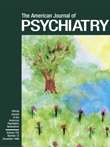Saccadic Eye Movements in Families Multiply Affected With Schizophrenia: The Maudsley Family Study
Abstract
Objective:Family studies have shown that abnormalities of smooth pursuit eye movement are increased in the adult relatives of schizophrenic probands as well as in the probands themselves. More recently, an inability of schizophrenic subjects to inhibit reflexive saccades reliably has been shown. This study aimed to test the hypothesis that the latter dysfunction is part of the extended schizophrenia phenotype.Method:With the use of infrared oculography, measurements of reflexive saccades and antisaccades were undertaken in 29 probands with schizophrenia, 50 of their nonpsychotic first-degree relatives, and 38 unrelated healthy volunteers. Results:Probands, relatives, and healthy subjects showed no overall differences in the generation of reflexive saccades. However, in the antisaccade task, probands showed more saccadic distractibility when they were required to inhibit reflexive saccades. Analysis of corrective saccades showed that this was not due to failed comprehension or motivation. Relatives of the probands with high saccadic distractibility showed a higher distractibility rate than relatives of the probands with normal distractibility. Across all subjects, females showed a higher rate of distractibility errors than males. Conclusions:The ability to suppress reflexive saccades is an objective neurocognitive measure that is impaired in schizophrenic patients and in a proportion of their biological relatives. This antisaccade abnormality may be a vulnerability marker in a subset of schizophrenic patients and their families. Am J Psychiatry 1998; 155: 1703-1710



